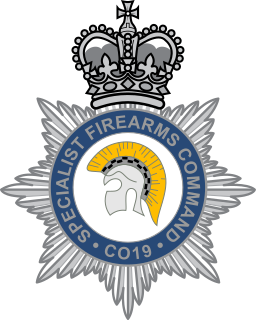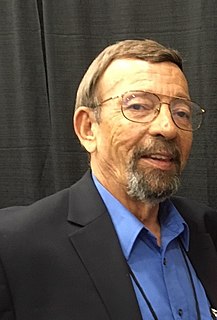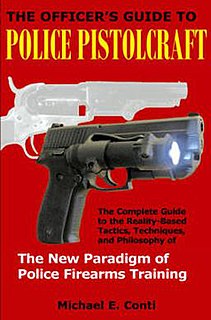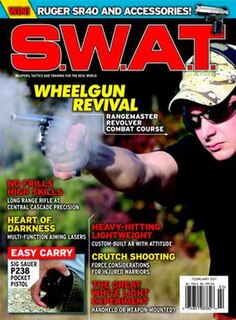Gun laws and policies, collectively referred to as firearms regulation or gun control, regulate the manufacture, sale, transfer, possession, modification, and use of small arms by civilians. Laws of some countries may afford civilians a right to keep and bear arms, and have more liberal gun laws than neighboring jurisdictions. Countries that regulate access to firearms will typically restrict access to certain categories of firearms and then restrict the categories of persons who may be granted a license for access to such firearms. There may be separate licenses for hunting, sport shooting, self-defense, collecting, and concealed carry, with different sets of requirements, permissions, and responsibilities.

Glock Ges.m.b.H. is a weapons manufacturer headquartered in Deutsch-Wagram, Austria, named after its founder, Gaston Glock. While the company is best known for its line of polymer-framed pistols, it also produces field knives, entrenching tools, and apparel.

In the United States (U.S.), a marksmanship badge is a U.S. military badge or a civilian badge which is awarded to personnel upon successful completion of a weapons qualification course or high achievement in an official marksmanship competition. The U.S. Army and the U.S. Marine Corps are the only military services that award marksmanship qualification badges. However, marksmanship medals and/or marksmanship ribbons are awarded by the U.S. Navy, U.S. Coast Guard, and U.S. Air Force for weapons qualifications. For non-military personnel, different U.S. law enforcement organizations and the National Rifle Association (NRA) award marksmanship qualification badges to those involved in law enforcement. Additionally, the Civilian Marksmanship Program (CMP) and the NRA award marksmanship qualification badges to U.S. civilians. Most of these organizations and the U.S. National Guard award marksmanship competition badges to the people they support who succeed in official competitions.
Concealed carry, or carrying a concealed weapon (CCW), is the practice of carrying a weapon in public in a concealed manner, either on one's person or in close proximity. CCW is often practiced as a means of self-defense. Every state in the United States allows for concealed carry of a handgun either permitless or with a permit, although the difficulty in obtaining a permit varies per jurisdiction.

The Specialist Firearms Command (SCO19) is the firearms unit of the Metropolitan Police Service. The Command is responsible for providing a firearms-response capability, assisting the rest of the service which is not routinely armed.

A tactical light is a flashlight used in conjunction with a firearm to aid low-light target identification, allowing the marksman, law enforcement officer or soldier to simultaneously aim a weapon and illuminate the target. Tactical lights can be handheld or mounted to the weapon with the light beam parallel to the bore. Tactical lights also serve a role as a method of non-lethal force, used to temporarily blind and disorient targets or, in the case of a large metal Maglite with D batteries, police can use the flashlight as a billy club. Features particularly associated with tactical lights include shock resistance, reliability, lightweight construction and powerful, long-lasting batteries, and high light intensity. Tactical lights may have optional filters to produce colored light, e.g., red, to not attract bugs, or may emit only infrared radiation for use with night vision equipment. A sighting laser may also be added to a weapon-mounted tactical light.

Practical shooting, also known as dynamic shooting or action shooting, is a set of shooting sports where the competitors try to unite the three principles of precision, power, and speed, by using a firearm of a certain minimum power factor to score as many points as possible during the shortest amount of time. While scoring systems vary between organizations, each measures the time of which the course is completed, with penalties for inaccurate shooting. The courses are called "stages", and are shot individually by the shooters. Usually the shooter must move and shoot from several positions, fire under or over obstacles and in other unfamiliar positions. There are no standard exercises or set arrangement of the targets, and the courses are often designed so that the shooter must be inventive, and therefore the solutions of exercises sometimes varies between shooters.

Massad F. Ayoob is an American firearms and self-defense instructor. He has taught police techniques and civilian self-defense to both law enforcement officers and private citizens since 1974. He was the director of the Lethal Force Institute in Concord, New Hampshire, from 1981 to 2009, and now operates his own company. Ayoob has appeared as an expert witness in several trials. He served as a part-time police officer in New Hampshire since 1972 and retired in 2017 with the rank of Captain from the Grantham, New Hampshire, police department. On September 30th 2020, Ayoob was named president of the Second Amendment Foundation. His nickname is "the bad ass of self-defense."

Point shooting, also known as target- or threat-focused shooting, intuitive shooting, instinctive shooting or subconscious tactical shooting, is a practical shooting method where the shooter points a ranged weapon at a target without relying on the use of sights to aim, where the emphasis is more on fast draw and trying to score preemptive hits first. In close quarters combat where life-threatening situations often arise suddenly leaving little reaction time for precise aiming, it is difficult to apply proper marksmanship techniques without risking oneself to be hit and thus suffer injury or get killed, which is why point shooting advocates a less sighting-oriented style of shooting prioritizing on achieving a tactical advantage through quick fire superiority and suppression.
Combat pistol shooting is a modern martial art that focuses on the use of the handgun as a defensive weapon for self defense, or for military and police use. Like most martial arts, combat pistol shooting is practiced both for defense and for sport.
Gun politics and laws in Mexico covers the role firearms play as part of society within the limits of the United Mexican States. Current legislation sets the legality by which members of the armed forces, law enforcement and private citizens may acquire, own, possess and carry firearms; covering rights and limitations to individuals—including hunting and shooting sport participants, property and personal protection personnel such as bodyguards, security officers, private security, and extending to VIPs.
Tap, rack, bang (TRB) or tap, rack, and go is jargon for the response to a failure to fire in a firearm with a removable magazine. This is designated as an "Immediate Action" and involves no investigation of the cause, but is effective for common failures, such as defective or improperly seated ammunition magazines.
- Tap – to tap the magazine. This is to ensure that the magazine is properly/completely inserted in the firearm so that it feeds properly. As typically taught in tactical firearms courses, the "tap" is applying pressure on the floor plate of the magazine to lock it into place. It does not constitute 'smacking' the magazine, as this can irreversibly damage the magazine's lip.
- Rack – pull back sharply and then quickly release the cocking handle/slide of the firearm. This will eject a misfired round, which could be a possible cause of the stoppage, and to chamber the next round.
- Bang/Go – aiming and firing the firearm again. If the firearm again does not fire or fails to extract the spent round, it may indicate a more serious problem with the firearm, requiring maintenance. For instance, if the firing pin is too lightly striking the primer on a cartridge, it may indicate a worn-out spring or firing pin.

In the United States, open carry refers to the practice of visibly carrying a firearm in public places, as distinguished from concealed carry, where firearms cannot be seen by the casual observer. To "carry" in this context indicates that the firearm is kept readily accessible on the person, within a holster or attached to a sling. Carrying a firearm directly in the hands, particularly in a firing position or combat stance, is known as "brandishing" and may constitute a serious crime, but that is not the mode of "carrying" discussed in this article.

Concealed carry, or carrying a concealed weapon (CCW), is the practice of carrying a weapon, either in proximity to or on one's person or in public places in a manner that hides or conceals the weapon's presence from the surrounding observers. The opposite of concealed carry is called open carry.
Proposition B in Missouri was a failed 1999 ballot measure that would have required local police authorities to issue concealed weapons permits to eligible citizens. It was a contentious issue and was narrowly rejected at the time by the electorate, but the legislature later approved similar legislation in 2003.

Gunsite is a privately run firearms training facility based in Yavapai County, Arizona, just south-west of Paulden in the United States. It offers tuition-based instruction in handgun, carbine, rifle and shotgun shooting, as well as other specialty firearms. Located on a 3,000-acre (12 km2) facility, Gunsite has classrooms, indoor and outdoor firing simulators, and various pistol and long-barrel ranges. The ranges go out to 2000 yards for precision rifle training. There is also an on-site pro shop and gunsmith.

The Officer's Guide to Police Pistolcraft is a 2009 non-fiction book by Michael E. Conti which covers combat-related situations arising in the course of standard law enforcement. Together with Police Pistolcraft, it forms the basis for the current pistol training program of the Massachusetts State Police and has been adopted by a range of other law enforcement jurisdictions.

SWAT is a monthly magazine dedicated to firearms, law enforcement and other tactical-related activities in the United States with a special focus on SWAT police officers.

A laser sight is a device attached or integral to a firearm to aid target acquisition. Unlike optical and iron sights where the user looks through the device to aim at the target, laser sights project a beam onto the target that provides a visual reference point. Although lasers in the visible part of the spectrum are most common, invisible infrared (IR) lasers may be used in conjunction with a night vision device. As they are offset from the barrel, laser sights need to be zeroed in, much like a conventional sight, so that the beam intercepts the point of impact at a chosen distance. Devices may include one or both types of laser, with some models also incorporating a rangefinder, flashlight, or IR illuminator. Laser sights may be attached to the existing sighting mechanism, the trigger guard, via a rail system, or can be integrated into replacement components such as the guide rod or grip plates. Some variants are also incorporated into other attachments such as foregrips.

Paul R. Howe is an American former special operations soldier. He was a Delta Force team leader who was involved with special operations as a U.S. Army soldier. He was involved in the special operations rescue at the Battle of Mogadishu (1993) which led to the book Black Hawk Down: A Story of Modern War and the Black Hawk Down film. He is a firearms instructor and counterterrorism expert who trains people in high-risk operations. His company is called CSAT-Combat Shooting and Tactics. He is the author of three books about leadership.














